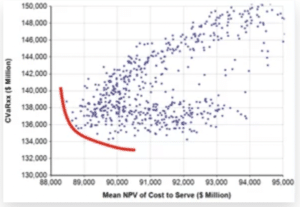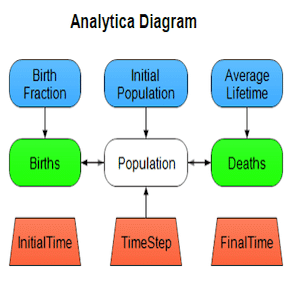How does the US Pacific Northwest plan to keep electricity cheap and reliable given the uncertain effects of climate change on the Columbia River Basin?

The Northwest Power and Conservation Council is responsible for coordinating long-range resource planning for electric utilities in the region, including the states of Idaho, Montana, Oregon, and Washington. Every five years, the Council must update their 20-year power plan to ensure that the region’s utilities can provide economic and reliable power. The Council uses a sophisticated computer program, called Resource Portfolio Model (RPM), to help find the most cost effective strategies that will meet demand within emissions limits, subject to a range of uncertainties.
The challenge
For decades, the Council had used the Resource Portfolio Model (RPM) to explore and optimize plans to expand generation capacity to meet uncertain electricity demand. RPM uses probability distributions to represent uncertainties about demand growth, fuel prices, and the cost of building new generation, as well as the effect of climate change on hydropower. It explores a sample of 1500 possible future scenarios. It uses nonlinear optimization to identify the least-cost strategies for retiring and adding generation capacity. In 2014, the legacy version of RPM was a loose collection of several platforms, including Excel, Visual Basic, and more. It was not user-friendly or transparent and was hard to maintain. The Council decided that it needed to be replaced. They sought a new tool that was robust, transparent, flexible, and much faster.
Why Analytica?
The Council put out a request for proposals to build a replacement RPM that would be far more transparent, robust, robust, flexible, and maintainable than their legacy system. In response, Navigant Consulting (now Guidehouse) proposed an approach using Analytica, specifically Analytica Decision Engine (ADE). In addition to meeting the client’s needs, it would let them rapidly build and extend the model. It would provide them the needed flexibility and transparency to make it easy for the client to review and understand the model. Cory Welch, the lead consultant of the Navigant team said:
“The Analytica modeling platform is nothing short of genius. Its visual environment, Intelligent Arrays, integrated Monte Carlo analysis capability, structured optimization, and ease with which you can create graphical user interfaces makes this the perfect tool for solving my client’s modeling needs. My clients are always impressed when they see a model we’ve built using Analytica, and it helps us stand apart from the competition.” — Cory Welch, Lead Consultant and RPM developer, Navigant Consulting (now at Resource Innovations, Inc.)
The solution
Navigant Consulting teaming, won the bid to redevelop RPM using Analytica. Cory Welch, then at Navigant, led the project including the design and development of the new model. The new Analytica model integrates components that were previously in four separate software platforms into a single decision analysis tool that Council staff could operate themselves. It employs Monte Carlo simulation to treat the uncertainties, linear programming for economic dispatch, and nonlinear optimization for capacity planning. It integrates these elements into a system dynamics model that represents interactions and feedback cycles over time. The model runs stochastically and optimizes the resource capacity plan over a 20-year time horizon, including both supply (new generation) and demand-side resources (conservation and demand response).

Stochastic optimization is always computationally intensive, even with RPM’s elegant formulation. To speed up calculation, Lumina provided a way to distribute the computing load over a cluster of ten computers, where each processor uses Analytica to compute a subset of the full 1500 scenarios. It then reassembles the results for further analysis.
The model enables analysis of tradeoffs between risk and cost, using an efficiency frontier plot

The model development was under a tight schedule to provide support for the Council’s 7th Northwest Power Plan by 2016. Cory Welch and his team delivered the model on time, exceeding expectations in terms of functionality and speed.
“The amount of work for you guys did for the money we gave you was amazing. You also provided more capability than we had required.” Ben Kujala, Director of Power Planning, Northwest Power and Conservation Council.
A version of the model with results was made accessible to stakeholders online via the Analytica Cloud Platform. The transparency and accessibility of the model helped the Council to gain buy-in with these stakeholders.
“Analytica is a great tool. It’s great to have stakeholders be able to go online and understand what’s going on. Getting buy-in is much easier.” John Ollis, Systems Manager, Northwest Power and Conservation Council.
The Council continues to enhance the model to meet evolving needs. It was used to develop the 2021 Northwest Power Plan, adopted by the Council in February 17, 2022. It includes a six-year action plan for 2022 to 2027 that calls for developing at least 3.5 GW of renewable resources to replace 60% of the region’s coal fleet due to retire by 2028. It adds up to 1 average GW of energy efficiency to the cumulative 7.2 average GW of energy efficiency added since the Council’s first plan in 1982.
Customer
The Northwest Power and Conservation Council was the client for this project.


Authors
Cory Welch was the lead consultant and model developer, first at Navigant Consulting (now Guidehouse), and then at Resources Innovations, inc, as Principal, Strategy and Planning. Lumina Decision Systems helped in formulating the optimization, and in setting up Analytica to run in a distributed configuration on a cluster of 10 processors.
For more
For more information, see the Northwest Power and Conservation Council’s:







